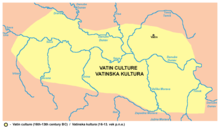|
Vatin culture
The Vatin culture (Serbian: Ватинска култура, Vatinska kultura or Ватинска група, Vatinska grupa) is a name of a prehistoric Bronze Age culture, which was named after Vatin, a village in Serbia. The culture had Indo-European roots and was culturally connected with Mycenaean Greece.[1] The Vatin culture is dated to the middle Bronze Age and is generally divided into three phases: Pančevo-Omoljica, Vatin-Vršac, and Belegiš-Ilandža.[2] It flourished from c. 2000 BC to 1500 BC,[3] or until the 13th century BC according to some sources.[4] The people of the Vatin culture inhabited the entire territory of Vojvodina (Banat, Bačka, Syrmia) and many surrounding areas (including Slavonia, Oltenia, Bosnia and Central Serbia). Its core area was in Serbian-Vojvodinian Podunavlje.[2] The remains of this culture were discovered at the beginning of the 20th century near the village of Vatin (Banat region, Vojvodina province, Serbia). However the real importance of this culture was only realised at the end of the 20th century, when the locality of Feudvar near the village of Mošorin was investigated. Characteristics The Vatin culture was highly influenced by Mycenaean Greece and had already developed social differentiation within its population. The culture also developed large central settlements, which were surrounded by smaller settlements and farms. Large settlements were economical and social centers, as well as the seats of tribal leaders. These fortified centers had a defensive character and a large number of them existed in the wider area. The thick network of large fortified settlements represents an example of the collective defense of a wide space.  The site of Feudvar in Serbia was an important proto-urban settlement and central place located on the edge of the Titel plateau, above a steep escarpment overlooking the Tisza river and plains below. It consisted of a central fortified tell of 2 hectares, surrounded by an open settlement of up to 6 hectares at its greatest extent. An average of 1000 people are estimated to have lived in the tell itself. There is evidence of craft specialisation, social differentiation and the presence of a ruling elite at the site. Houses were 5-6 m by 10-12 m in size, laid out in a dense rectangular pattern with wide alleys and small squares between them.[7][8] The main occupations of inhabitants of the Vatin culture were agriculture and animal husbandry and it is assumed that they also produced beer. In many of the settlements, remains of children's toys were discovered. Tools, weapons and jewelry were mainly purchased by trade, but some larger settlements also had their own workshops that produced bronze objects. One foundry of bronze objects was discovered in Feudvar, and according to the researchers, it was probably used for several hundreds of years. There are indications that people of the Vatin culture also had basic mathematical knowledge. According to Anthony (2007), chariotry spread westwards to the Vatin culture from the Multi-cordoned ware culture.[9] Gallery
LocalitiesLocalities of the Vatin culture are:[2][10] See also
References
Further reading
External linksWikimedia Commons has media related to Vatin culture.
|
||||||||||||||












